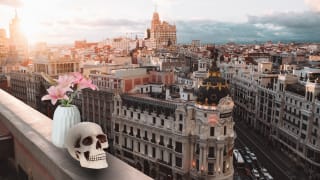The future of cities: connecting people and places
By Caio Esteves, Global Director of Placemaking at Bloom Consulting
To talk about cities is first and foremost to talk about people and how people interact within public places.
As always, it is important to remember that places are only places because we, people, give them meaning. Without it, these spaces would be nothing more than empty portions of the earth without any symbolic aspect, almost invisible to the most inattentive eyes. A place is a social, collective, or private construction. A place can have an individual meaning, “your” place, or a collective- even tribal - meaning. But still, almost every time, the place that we call “ours” is shared by several other people, whether you like it or not.
A very simple and almost childish exercise is to imagine “your” place in the world. Of course, here we refer to a place that is, as a bare minimum, collective and accessible; the bathroom of your suite or the dining room of your grandmother does not count. We will refer here to that place where, when you arrive, you feel at home, that place that you consider “your place in the world,” a place you understand and have a clear feeling that it understands you. Thinking about this place, we ask the question: Have there been other people in this same place? Very few people think of a deserted beach with the wind shaking the palm trees. The vast majority think about a place, shared with several other people. This leads us, among other conclusions, to the idea that by adopting a place as "ours" we also adopt the people who frequent it as "our" group. Rarely will we love a city but hate its residents. After all, people, like you, chose the places that they identify themselves with, simple as that.
Connecting place branding and placemaking
Although now considered a trendy subject, I remember perfectly attending my first Global CNP, which was also the first City Nation Place event ever in 2015, and being shocked to find that almost no one knew what I was talking about when discussing the connection between place branding and placemaking. It seemed not to exist to them, and the reverse was true in the international placemaking congresses, where place branding was dismissed as less relevant - merely an idea to sell places where no one wants to visit or live. The exception to the rule came from a well-presented, very polite gentleman who, almost solely by professional courtesy, came to talk to me. As an urban planner like me, he quickly understood what I referred to when talking about the importance of connecting an umbilical cord between the place branding and placemaking of a location. Today, in a fortunate turn of events, this figure is my business partner - Malcolm Allan, the President, Nation and Place Branding director at Bloom Consulting.
It is no longer feasible to think of place branding strategies without connecting them to the way people will live in the place in question. It is necessary to “go down” some steps and connect intellectual and often academic thinking to the reality of human coexistence in the urban environment. Years later at another Global CNP, in an attempt to explain in marketing terms what I was referring to with placemaking, I made an analogy that served me for a long time: placemaking is an urban brand experience. But today, this definition is absurdly reductionist: it is not only a brand experience, but how people can live and have their lives transformed through urban coexistence, even guided by a place brand. If a place brand is a feeling about a city, region, or country, placemaking is the experience of these same people in this same place. If place branding is perceived, placemaking is experienced and it is precisely in this multi-sensory experience that resides its strength and importance.
From functionality to hedonism
. The pandemic certainly accelerated trends already underway, and two of them quite significantly: deterritorialization and dematerialization. As people were locked in their homes in the places they lived, these places lost much of their meaning. Once indoors, whether in London or Brazil, with internet/electricity and the post office service, you would be inhabiting almost the same virtual place. At this point, the cities and the world momentarily transformed into large "non-places."
From a placemaking perspective, this discussion changes a couple of things. The main one, which guides everything else, is the idea of the city no longer as a strict or mostly functional place, but mainly hedonistic. For example, if dematerialization allows us to work and study from home and virtually any existing product can be delivered comfortably to our addresses via the internet, the city has become less functional. The city is no longer purely the landscape that frames the path from point A to point B, such as from house to work. Instead, it is reworked as the protagonist, the very reason we go through it. And in turn, this prompts some new behaviours from us as place branders and placemakers.
The first of these is a need for more public spaces. If we used to say that the quality of a city can be measured by the quality of its public spaces, this statement has become even more relevant since 2020. If hedonism has replaced functionalism, the city needs to be prepared to deal with this new demand and expectation. If green spaces have always been necessary and desirable, this demand has multiplied in today's world. Not only by the need but by the very understanding that a network of small green spaces, with more local access, can be more interesting than the great modernist public parks.
One of the great lessons is precisely the importance of the small scale. This isn’t a disruptive idea, but rather a discussion that was already ongoing. The small scale of the gathering, the small scale of coexistence, and the small scale of local business is always related to the shorter and more accessible distance;, proximity was clearly of great importance during the pandemic and in many ways, helped strengthen the support for small local commerce, a movement that was also ongoing before the pandemic.
The importance of co-creation
Finally, it is worth highlighting another essential point for placemaking that is even more relevant in the current world and the future of cities: the need for popular participation. This is one of the characteristics of Placemaking.ID®, which is the methodology we use at Bloom Consulting, with community engagement as one of the starting points. It is clear that a place is made by people, and so nothing is more essential than the participation of this community in decision-making processes. Strong communities, with a solid sense of belonging, survive in times of crisis rather than communities where the sense of belonging does not exist.
To give voice to people is to contribute to the creation of strong communities. At the same time, it is not enough to just listen; you need to engage, collaborate, and co-create. To make a quick analogy to the famous quote from Brazilian writer Millôr Fernandes, without active community participation, the future of cities will have a great past in front of them.
CEO of Bloom Consulting, Jose Torres, is joining us on a webinar this May 24th to share new research into the factors that make up nation brand perceptions. Learn more and register for free here.









